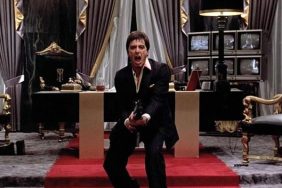Brian De Palma’s Scarface has become, in no uncertain terms, a cultural phenomenon. His 1983 adaptation of Howard Hawks’s and Ben Hecht’s 1932 gangster classic, also named Scarface, took the original film’s themes of immigration, organized crime, youthful indulgence, and the commoditization of the “American Dream” and transformed it into an operatic, F-bomb laced, ultraviolent saga that so wallowed in its own crapulence that the simple, moral point of the story – put simply, “Don’t do this” – was thoroughly lost on what is now multiple generations of fans who idolize the protagonist Tony Montana, or at least respect him for living a lifestyle unencumbered by compromise, moderation, ethics, or good taste. Although this ultra-violent remake has achieved legions of fans and can now safely be called a “classic,” its failure to convey its own message brings it down a notch in my eyes. The new, Scarface Limited Edition Steelbook Blu-Ray set (out this week) is a loving and impressive presentation of a film that perhaps deserves just a little less love.
The film, for those who haven’t seen it, tells the story of Tony Montana, played with manly bravado by Al Pacino. Montana is a Cuban immigrant who pursues the American Dream, or at least the American Dream as he perceives it: the accumulation of power and wealth at almost any personal cost. As the film was made in 1983, his image of success takes the form of outlandishly designed interior decoration, fancy cars, and piles of cocaine that sit on his desk like a scale model of the Paramount logo. Joined by his childhood friend Manny Ribera, he mows his way through his enemies and benefactors alike in a bloody rampage that director Brian De Palma romanticizes with lush, colorful cinematography, a suave score by Giorgio Moroder and a bloated running time that turns Montana’s story into an American epic, similar in scope (but not quality) to Gone with the Wind and The Searchers.
This Blu-Ray version of Scarface comes accompanied by a DVD of Howard Hawks’s original 1932 film, which starred the great Paul Muni as the titular character. In the original film, based on the life of celebrity gangster Al Capone (still alive, well and powerful at the time of production), Antonio ‘Tony’ Camonte is a young upstart Mafioso who allies himself with an older, wiser criminal mind Johnny Lovo, played by Osgood Perkins. Structurally the two films are very similar: the “hero” gains power by his Keyser Soze-ish willingness to do anything necessary to become an underworld kingpin, but once he achieves said power he lacks the guile and moderation necessary to maintain it. Muni is electric in the lead role, and together with Hawks and screenwriter Ben Hecht crafts a canny, genuine American Classic at a brisk 93 minutes. The occasional, overt moralization may not play well to modern audiences but at least the message of the film is clear.

There’s one scene in particular that appears in both versions of the film that the 1932 Scarface completely nails, but the 1983 remake thoroughly fails to capitalize on. It’s the moment when young Scarface enters his boss’s home for the first time, thoroughly wowed by his lifestyle but ignoring his words of wisdom which, in all fairness, are easily obfuscated by the outlandish but superficially impressive things that he owns: a beautiful home, expensive booze, high class cigars and, most importantly, a woman (Karen Morley in the original, Michelle Pfeiffer in the remake) whose affections are easily bought. She won’t give Scarface the time of day, and soon comes to represent his life’s ambition to own things, whether or not he deserves them. This distinction is made clear in the original Scarface, but perhaps due to Al Pacino’s complicated performance – or perhaps De Palma’s tendency to emphasize style over substance, or perhaps Oliver Stone’s none-too-subtle script – this focal point of the story is minimized in the 1983 remake.
Tony Montana thinks too highly of himself and even Americam capitalism to admit that he’s in it for the money. As he tells Manny: “In this country, you gotta make the money first. Then when you get the money, you get the power. Then when you get the power, you get the women.” He says that money is a means to an end, but in fact both he and the film are more enamored with possessions than anything else. It’s a muddied theme and the film perhaps doesn’t suffer, but certainly offers as a result a confusing message about youthful pride and the rewards – and lack thereof – that result from unchecked ambition. And the subplot about his borderline incestuous affection and protectiveness of his sister (the incredibly sexy Ann Dvorak in the original film, Mary Elizabeth Mastranonio in the remake) somehow seems less scandalous in Brian De Palma’s over-the-top version, giving their relationship less dramatic power as a result. That said, De Palma’s film places greater emphasis on the still-topical immigrant aspect of Scarface, skillfully idolizing – in an outlandish manner, obviously – the perception of American success through the eyes of those who, before coming to our shores, had little hope of achieving anything like it.
Although De Palma’s Scarface is no doubt a bloated retelling of the original, crisp story, it remains spectacular entertainment from start to finish as long as you don’t take it too seriously. Pacino’s iconic performance and easily-impersonated Cuban accent, complete with classic lines like “Say hello to my little friend!” and repeated, luxurious utterances of the word “cock-a-roach” make him one of the most memorable on-screen heroes, anti- or otherwise, in cinema’s admittedly brief history. And it’s easy to enjoy the wish fulfillment fantasies of fame, riches, drugs and gaudy paintings in your own honor, so long as you ignore the ending that thoroughly condemns that kind of selfish behavior.

The Scarface Limited Edition Steelbook is easily the best De Palma’s version of the film has ever looked on home video. It’s bright, colorful and thoroughly sumptuous, but it’s not perfect: Digital Noise Reduction (DNR) is common, which smears away fine detail and gives the actors an occasionally waxy appearance, like they’re wearing far too much foundation (which they very well might have been). The surround sound mix, however, has no deficiencies whatsoever, and blasts through each speaker with power and drive. The special features are almost entirely carted over from previous, and loaded, special edition DVD releases, with the exception of Def Jam’s documentary about the film’s influence on Hip Hop culture, so unless you really plan on watching that short special feature over and over again there’s no reason not to replace your DVD copy of Scarface. New features are slim but excellent, including a new retrospective called The Scarface Phenomenon, and a U-Book option that plays many of the special features as a picture-in-picture presentation with the film itself, and keeps track of the violence and F-bombs in handy counters on the side of the screen. It can’t show both at once, unfortunately, and the sound sometimes dips or spikes dramatically when the picture-in-picture pops up or disappears, but these are nitpicks. It would have been nice to have a Blu-Ray edition of the original Scarface, but the DVD included is a very nice presentation that includes the alternate, Hays Code-certified ending.
If you’re a fan of Brian De Palma’s Scarface, there’s no reason not to buy the Scarface Limited Edition Steelbook. It’s a mostly exemplary tribute to an immensely popular film, warts and all.
CRAVEONLINE RATING (Brian De Palma’s Scarface): 7.5/10
CRAVEONLINE RATING (Howard Hawks’s Scarface): 9/10
CRAVEONLINE RATING (Blu-Ray): 9/10








